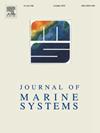Three-dimensional structures of mesoscale eddies in the subtropical countercurrent and Kuroshio extension regions and their vertical normal modes analysis
IF 2.5
3区 地球科学
Q2 GEOSCIENCES, MULTIDISCIPLINARY
引用次数: 0
Abstract
This study investigates the three-dimensional structures of temperature, salinity, density, and pressure anomalies of cyclonic and anticyclonic eddies in the Subtropical Countercurrent (STCC) and Kuroshio Extension (KE) regions using composite analysis and vertical normal modes methods. The results show that maximum temperature and density anomalies in the upper mixed layer are displaced westward for cyclonic eddies and northwestward for anticyclonic eddies relative to the eddy center, while anomalies below the mixed layer display quasi-isotropic structures. Sea surface salinity anomalies are shifted northwest of the eddy center and exhibit a dual-core vertical structure influenced by the background salinity field. In both the KE and STCC regions, anticyclonic eddies cause greater maximum temperature and salinity anomalies but at shallower depths compared to cyclonic eddies. Analysis of pressure anomalies reveals that eddy vertical structures are surface-intensified in the STCC region, with an average influence depth of 508 m, but extend deeper in the KE region, with an average influence depth of 613 m. Cyclonic eddies generally penetrate deeper than anticyclonic eddies. The vertical structure of eddies is dominated by the barotropic mode and the first baroclinic mode, with the first two modes accounting for 80 % of the variability. Contributions of the barotropic mode increase from the STCC to the KE region, with cyclonic eddies having higher barotropic mode ratio than anticyclonic eddies. The vertical influence depth of eddies is largely determined by the barotropic component, with greater barotropic contributions corresponding to deeper penetration.
副热带逆流和黑潮扩展区的中尺度涡旋三维结构及其垂直正态分析
本文采用复合分析和垂直正态模态方法研究了副热带逆流(STCC)和黑潮延伸(KE)区气旋和反气旋涡旋的温度、盐度、密度和压力异常的三维结构。结果表明:相对于涡旋中心,上层混合层的最高温度和密度异常向西移动,反气旋涡旋的最高温度和密度异常向西北移动,而下层混合层异常则呈现准各向同性结构。受背景盐度场影响,海面盐度异常向涡旋中心西北方向移动,呈现双核垂直结构。在KE和STCC区域,与气旋涡旋相比,反气旋涡旋引起更大的最高温度和盐度异常,但在较浅的深度。压力异常分析表明,涡旋垂直构造在STCC区表层强化,平均影响深度为508 m,而在KE区扩展更深,平均影响深度为613 m。气旋涡旋通常比反气旋涡旋穿透更深。涡旋的垂直结构以正压型和第一斜压型为主,其中前两种模态占变率的80%。正压模态的贡献从STCC向KE区域增加,气旋涡旋的正压模态比高于反气旋涡旋。涡旋的垂直影响深度在很大程度上取决于正压分量,正压分量的贡献越大,穿透越深。
本文章由计算机程序翻译,如有差异,请以英文原文为准。
求助全文
约1分钟内获得全文
求助全文
来源期刊

Journal of Marine Systems
地学-地球科学综合
CiteScore
6.20
自引率
3.60%
发文量
81
审稿时长
6 months
期刊介绍:
The Journal of Marine Systems provides a medium for interdisciplinary exchange between physical, chemical and biological oceanographers and marine geologists. The journal welcomes original research papers and review articles. Preference will be given to interdisciplinary approaches to marine systems.
 求助内容:
求助内容: 应助结果提醒方式:
应助结果提醒方式:


